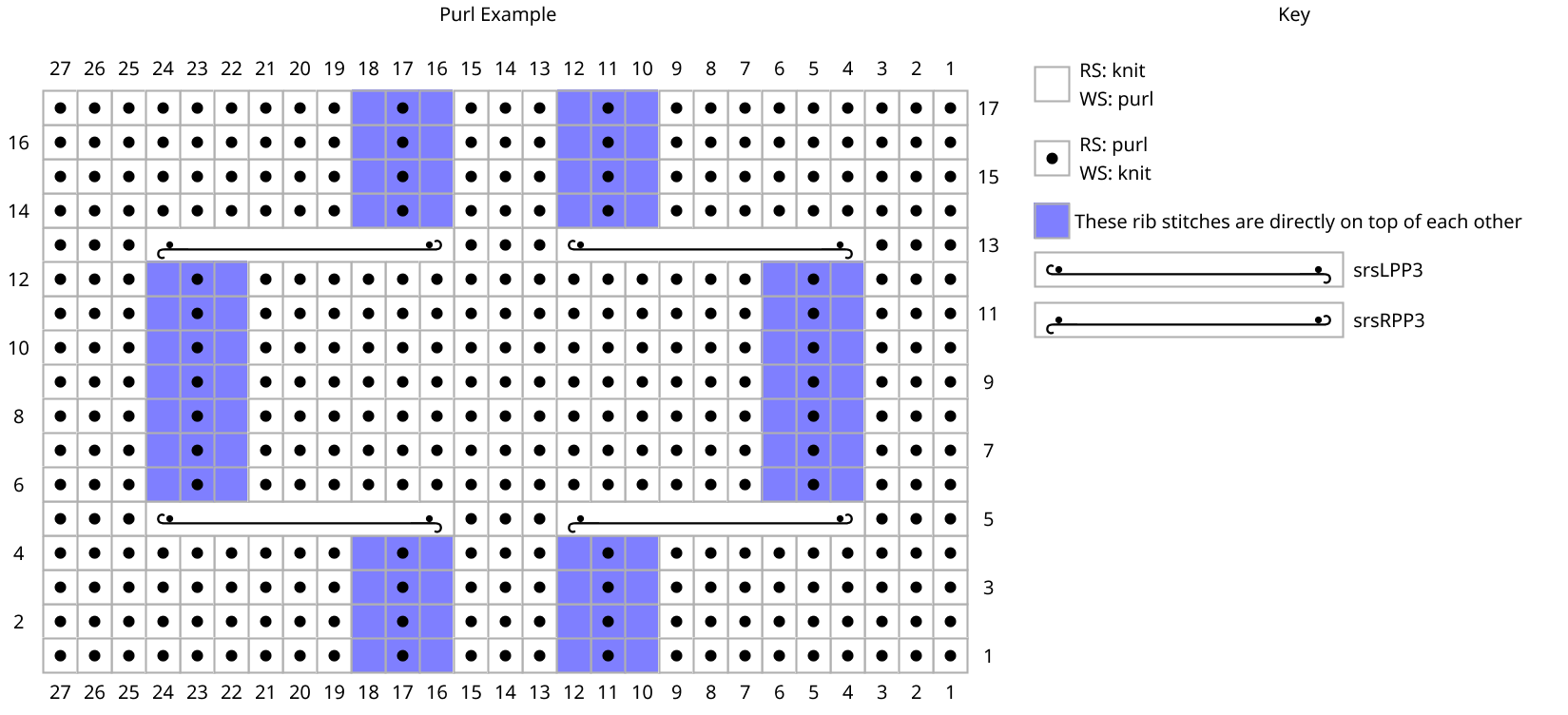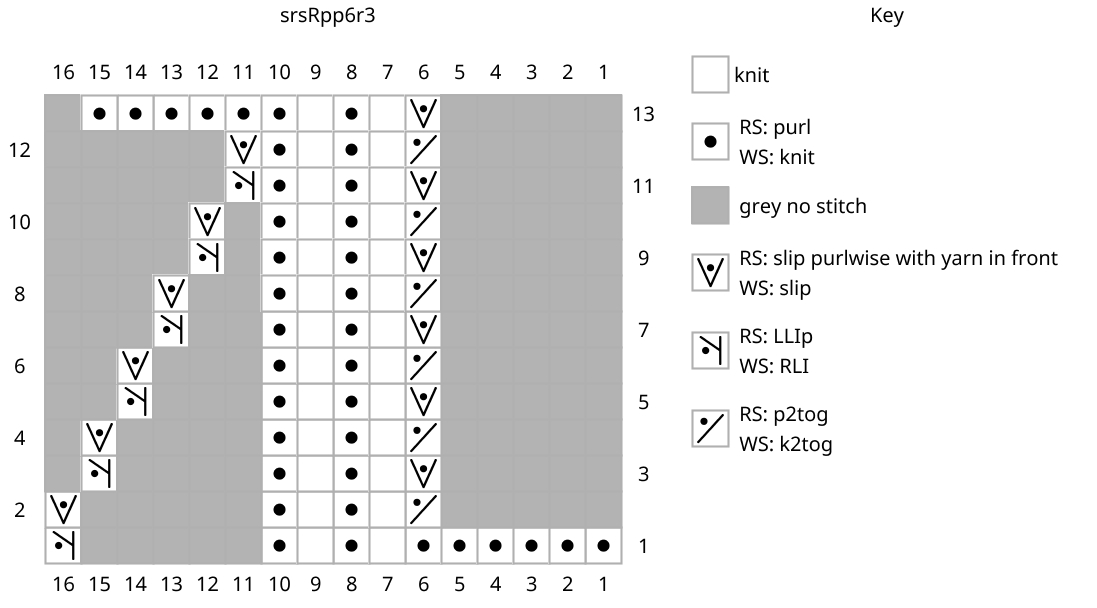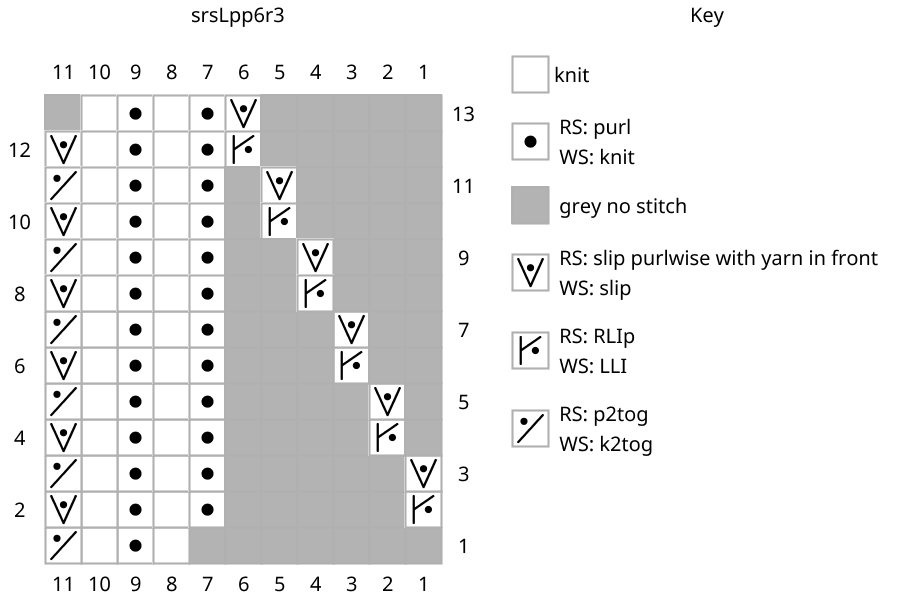
I introduced the Short Row Slide idea in this post, it’s a way of making a column of ribbing look as if it were sliding horizontally. The individual slides are all explained with written instructions and charts in the (soon to be released) patterns, but I wanted to explain how and why I dealt with each field. I wrote about dealing with Garter Stitch in this post. And dealing with Ribbed stitch in this post. And Working with Stockinette here.
The Nomenclature works like this:

a. L or R for left or right leaning slide for the bordering rib between the ogees as it rises
through the fabric.
b. In this part of the abbreviation, the field of fabric is listed as you come to them in your knitting. This is where knitting and English confuse each other; in the code the fields are listed left to right, but you come to them in your knitting from right to left. I read them out loud to myself, then follow that order on my needles when I’m proofing my pattern, when I’m knitting, I just read the stitches. The types of fabric fields you will encounter
are:
- g for garter
- P for reverse stockinette field
- K for stockinette field
- kpk for K1, p1, k1 ribbing
- pkp for P1, k1, p1 ribbing
c. the number of stitches that are sliding horizontally.
To explain how the slides work, I decided to go from the same field to the same field, but then I needed 3 rib stitches so that they would contrast with the stockinette fabric, not the pairs of ribbed stitches I used in Al-Andalus, Octans and Habib; where I was going from one field to a contrasting one. Going stockinette to stockinette, I wanted a purl column on each edge of the ribbing. With the slides I needed for the Octans shawl, and these blog examples, I added r# for the number of stitches in the rib. In this case, r3 for the three ribbed stitches that are sliding, so a right slide is called srsRkkr3.

Purl Example
Row 1 (RS): P9, k, p, k, p3, k, p, k, p9. (27 sts)
Row 2 (WS): K9, p, k, p, k3, p, k, p, k9.
Rows 3 – 4: Repeat Rows 1 – 2.
Row 5: P3, srsRPP3, p3, srsLPP3, p3.
Row 6: K3, p, k, p, k15, p, k, p, k3.
Row 7: P3, k, p, k, p15, k, p, k, p3.
Rows 8 – 11: Repeat Rows 6 – 7.
Row 12: K3, p, k, p, k15, p, k, p, k3.
Row 13: P3, srsLPP3, p3, srsRPP3, p3.
Row 14: K9, p, k, p, k3, p, k, p, k9.
Row 15: P9, k, p, k, p3, k, p, k, p9.
Rows 16 – 17: Repeat Rows 14 – 15.
While the left and right slides are reverses of each other, in a left slide, you work right up until the ribbing to begin. You do the same thing in a right slide, but the main chart symbol covers up the stitches you are working to get there, so they are included in the mini-chart. It’s a little weird to look at the instructions and have one be so much wider than the other, but that’s how it worked out.

srsRpp6r3
Row 1 (RS): P6, (k, p) x 2, LLIp. (11 sts)
Row 2 (WS): Sl, (k, p) x 2, k2tog. (6 sts)
Row 3: Sl wyif, (k, p) x 2, LLIp.
Rows 4 – 11: Repeat rows 2 – 3.
Row 12: Repeat row 2.
Row 13: Sl wyif, k, p, k, p6. (10 sts)
On the decrease side of the slides, after the turn, the first stitch is slipped so that the strand of yarn crosses on the purled side, which makes it almost disappear into the purl stitch. I could not slip the first stitch on the increase side, because on the following row there will be another lifted increase, and if no new stitch is there, you have to make all 6 increases into the same loop, which gets very tight!

srsLpp6r3
Row 1 (RS): K, p, k, p2tog. (4 sts)
Row 2 (WS): Sl, (p, k) x 2, LLI. (6 sts)
Row 3: Sl wyif, (p, k) x 2, p2tog.
Rows 4 – 11: Repeat rows 2 – 3.
Row 12: Repeat row 2.
Row 13: Sl wyif, (p, k) x 2. (5 st
So far everything is very like the ribbed example, but you may have noticed that the increases are one stitch removed from the ribbed columns which are sliding. This makes it look (on the knit side) as if a ring of continuous knit stitches are echoing the slides; because a decrease has the appearance of a prominent knit stitch, but an increase appears out of nowhere from a space in between stitches. I’m all about symmetry when I can get it, even if it’s on the other side of the fabric.
My Patterns Andalus and Habibi use these techniques.
- Click here to buy Andalus Blanket on Ravelry
- Click here to buy Andalus Blanket on lovecrafts with an Affliate Link that gives me extra money
- Click here to buy Habibi Blanket on Ravelry
- Click here to buy Habibi Blanket on lovecrafts with an Affliate Link that gives me extra money
Want to try a free pattern that uses short row slides? Sign up for my newsletter below.
